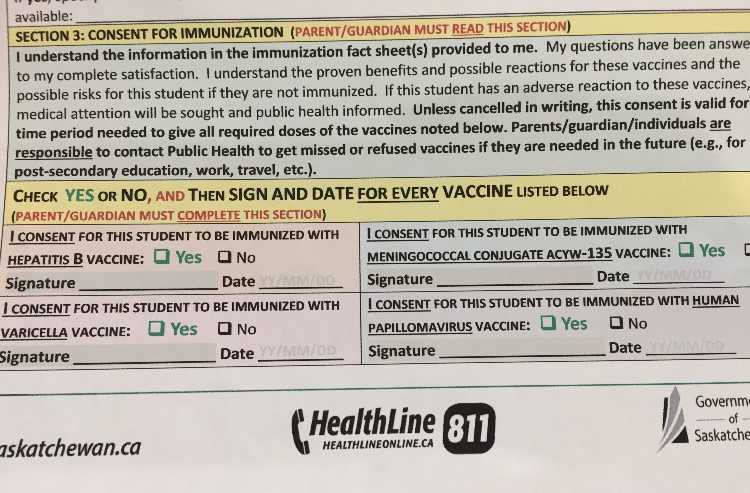After glancing over the immunization package my daughter brought home from school a number of questions popped into my mind. The fact sheet included a brief overview of the diseases the vaccines are meant to prevent, but nothing about the prevalence of these diseases where we live or the risks of contracting them. It stated that grade 6 students have been receiving these vaccines for years, but didn’t include the names of all the biological products or their effectiveness. Some common reactions caused by the vaccines were listed, but the only rare adverse reactions noted were vaccine-derived chickenpox and anaphylaxis a life-threatening allergic reaction. Pharmaceutical products can have some serious side effects. Are these biological products associated with any other serious effects?
The first thing to catch my eye on the attached consent form was the signature area for the vaccines. Beside each listed vaccine was a big green checkbox with the word “Yes” printed in bold green letters followed by a smaller black checkbox with the word “No” in smaller, thin black letters. It reminded me of the marketing tactics used by the sales flyers often referred to as junk mail.
I called public health to ask for the brand names of the products and was directed to more detailed fact sheets on the provincial government’s website. These ones listed the brand names and ingredients for the vaccines. They also contained a paragraph on mature minor consent that made the needle on my mom radar do a full revolution. Did you know that once your child is 13 years of age public health can approach them directly for consent? It’s one way of getting around so-called “vaccine-hesitant” parents. This is the label the vaccine industry applies to parents who question their products. Professional medical societies are enlisted to help handle these parents. Social science and humanities researchers with the Canadian Immunization Research Network (CIRN) are conducting studies to help the industry develop strategies to prevent these parents from progressing to so-called “anti-vaccinators”. What type of science-based evidence will these studies provide? As of March 2017, CIRN had received $30 million from the Canadian Government and vaccine manufacturers. This past June the Canadian Government allocated CIRN another $10 million until 2022.
Name-calling aside, how can parents give informed consent for these vaccines with incomplete information? I started asking my friends and neighbours about their experience with vaccines. I learned about a brother who got polio from the live polio vaccine, a son who suffered a serious adverse reaction from a vaccine through the school-based immunization program and can no longer be vaccinated, a mother whose adverse reaction to a flu vaccine means she can never have them again, a brother who developed H1N1 following vaccination for it, and a daughter who was given a double dose of the HPV vaccine because public health didn’t believe her when she told them that she had already been given a dose.
The deadline for parental consent forms had come, but I like to err on the side of caution and needed more time to review these products. I ended up making a trip to the public health office to deliver my consent form along with a letter indicating my decision to opt out of the school-based immunization program. I asked the public health nurse some questions about their fact sheets. Why are the serious risks of the vaccines not listed in the immunization package? Why are they administering them all at the same time? Where is the research showing this combination is safe? When would public health directly approach a child for consent? Is this a research study?
The public health nurse summoned an immunologist to help answer my questions. They informed me that the serious risks are not listed in the immunization package sent home because they are considered rare. All risks including rare ones should be disclosed to parents otherwise it’s not really informed consent. Vaccine combinations are given to increase coverage and reduce costs. Administering combinations of vaccines may be cheaper for the government, but is it safe for my child? An example of when public health would directly approach a child for consent is when they are not living with their parents. What information is provided to these children? There are no research studies on this specific combination of vaccines being given at one time. I think this is important information to consider in my risks/benefits analysis of these products. The school-based immunization program is not a research study. The immunization package contains a description of the provincial government’s electronic health record system for storing all of the data associated with their immunization program. Surely, this data must be used for post-marketing surveillance of these vaccines. Before I left, the immunologist recommended looking up Dr. Paul Offit, a well-known physician/scientist.
As I walked to my car I realized the risks/benefits analysis for a vaccine will be very different depending on which side of the needle you sit. My decision was not based on the mathematical modeling of population health and the theory of herd immunity or the cost-effectiveness of the immunization program; it was made in the best interest of my child, a unique individual whose health and life are invaluable to me. My child is a person, not a number. Who’s to say where the just balance lies when the weights and measures of population health are applied?
I was about to find out.
To be continued…

